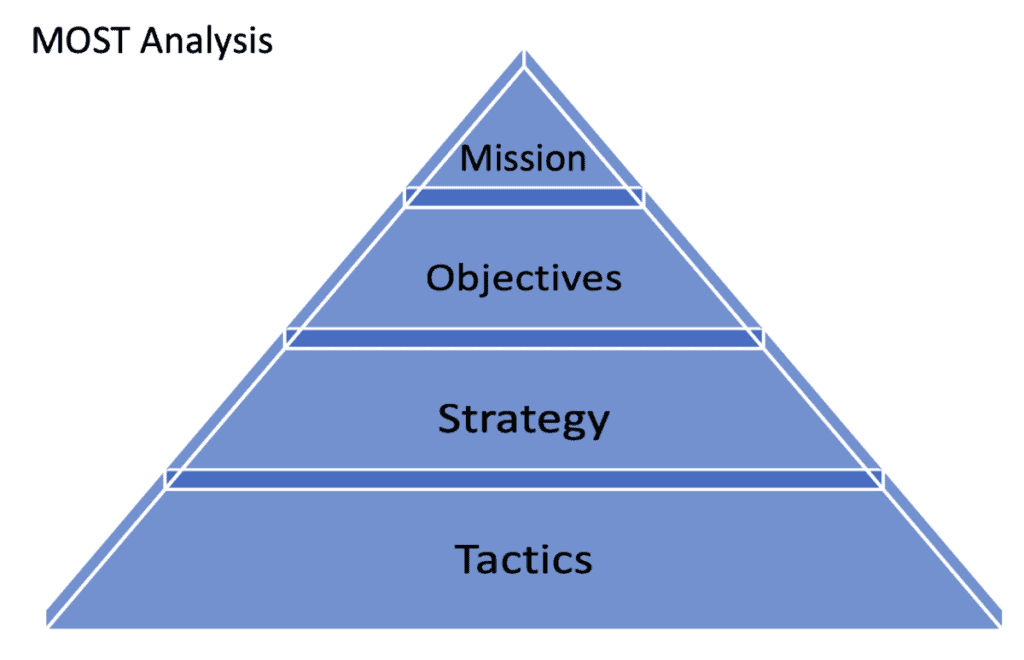MOST analysis is a useful strategic tool for analysing an organisation’s strategic plan. MOST stands for Mission, Objectives, Strategy, and Tactics.
- Mission: Defines the overriding direction and purpose of the organisation and should position the business to succeed.
- Objectives: Are the statements of specific outcomes that are to be achieved by the organisation. Objectives should be SMART– that is, Specific, Measurable. Achievable, Realistic, and Timely.
- Strategy: Defines the direction and scope of an organisation over the long term, which achieves an advantage in a changing environment to achieve organisational objectives. Strategy contains options to help meet the business objectives.
- Tactics: The short-term, operational plans and projects that will implement the strategy.
MOST analysis is used to analyse what the organisation has set out to achieve (the mission and objectives) and how it aims to achieve this (strategy and tactics).
MOST analysis provides a statement of intent for the organisation, and is usually created following some strategic analysis activity. It is also used during the strategy analysis
Table of Contents
Benefits of MOST Analysis
MOST Analysis provides the following benefits to a business organisation:
- Helps define what the organisation has set out to achieve (the mission and objectives).
- Determines how it aims to achieve this (strategy and tactics).
- Identifies, strengths, weaknesses, opportunities, and threats that the organisation faces.
- Helps the organisation communicate its purpose.
- Helps define business and transformation roadmaps to help enable the strategy.
- Enables alignment with stakeholders.
- Avoids day-to-day distractions and provides a basis for overall strategic direction.
How Do You Perform MOST Analysis?
So how do you perform the MOST analysis? There are four steps involved in MOST analysis:
- The first step in the MOST analysis is to define the organisation’s mission. The mission is essentially what the company aims to achieve to meet its strategic objectives, which are then broken down into tactics for action. It is important to have a mission to which most, if not all, stakeholders can subscribe. The mission needs to emphasise the common ground amongst stakeholders and not the differences.
- Objectives can be SMART
(specific, measurable, achievable, realistic, and time-bound). The MOST analysis also involves identifying both strategic objectives and tactical objectives. Strategic objectives are high-level objectives that the company wants to achieve in the long run, while tactical objectives are specific objectives that need to be achieved to meet the strategic objective. For example, a business might have a strategic objective of increasing market share. Under this, a tactical objective might be to increase sales by 25% year on year for the next six years. Objectives – both at the corporate and business unit level – are often expressed in financial terms. They could be the expression of desired sales or profit levels, rate of growth, dividend levels, or share valuations.
- The third step in MOST analysis is to understand the strategy of the organisation. MOST analysis helps define the strategy of an organisation to achieve its objectives, which are broken down into tactics for action.
- The final step in MOST analysis is to understand the tactics an organisation will use to achieve its objectives. The tactics will involve the short-term, operational plans and projects that will implement the strategy. The tactics will also include identifying the resources and capabilities required to successfully execute the tactics.
Increasingly organisations have been keen to develop and communicate a set of corporate values that define the way that the organisation operates. Of particular, importance is the organisation’s core values – these are the principles that guide an organisations actions.

MOST Analysis Example
The following is an example (at the headline level) of a MOST analysis:
- Mission: To improve the health and fitness of the New York population by the provision and promotion of fitness facilities and health clubs.
- Objectives: To reduce the incidence of coronary heart diseases by 3% by 2030.
- Strategy: To provide fitness facilities and health clubs in strategic locations around New York.
- Tactics: Build new fitness clubs in suburban places around New York and refurbish existing health clubs.
How Can MOST Analysis Help Your Business?
MOST analysis helps organisations identify areas that need improvement for them to become successful, while also highlighting strengths and opportunities which are already present. MOST analysis can help businesses to:
- Develop a clear understanding of what they want to achieve and how they plan to do this (mission, objectives, strategy, and tactics).
- Understand the strengths, weaknesses, opportunities, and threats which are faced by the company.
- Identify areas where they need improvement for them to achieve their objectives.
- Understand what is working well for the company and capitalise on this.
- Develop a workable plan to achieve their objectives (strategy, tactics, implementation steps).
MOST Analysis helps a business organisation with the following:
MOST analysis can help improve the effectiveness of your organisation’s strategy by providing clarity in regards to what it aims to do, how it plans on achieving this, and areas for development.
What Are Some Of The Challenges With MOST Analysis?
Some of the challenges of performing MOST analysis include:
- The MOST model can be difficult to implement in practice as it requires a high level of buy-in from multiple parties within the business (and often external stakeholders).
- MOST has been criticised as it can be difficult to measure the success of an organisation against its mission and objectives.
- MOST require a high level of commitment and effort to be successful.
- MOST analysis should not just involve senior management but also requires support from across the entire organisation, including other stakeholders such as customers and suppliers.
- MOST analysis can be a tricky technique to use when assessing internal capability. It is important to remember that merely defining and displaying a coherent MOST does not necessarily result in buy-in and motivation on the part of the staff.
What Is The Difference Between MOST Analysis And MARKET Analysis?
Market analysis is the process of evaluating the attractiveness and potential of a market for a product or service. MOST analysis, on the other hand, helps define how an organisation will become successful through its strategic planning. This involves taking the strategic and tactical objectives and actions and turning them into a workable plan. MOST analysis helps to identify the strengths, weaknesses, opportunities, and threats which are faced by the company.
What Is The Difference Between MOST Analysis And SWOT Analysis?
SWOT analysis is a way of identifying strengths, weaknesses, opportunities, and threats which are faced by the company. MOST Analysis takes this information one step further in that it helps to develop mission action plans for each strength or opportunity identified! This puts all of these objectives into a timeline with deadlines for each task! MOST analysis can be used when developing a new strategy or when revising an existing one!
What Is The Difference Between VMOST and MOST Analysis
What is VMOST? VMOST stands for Vision, Mission, Objectives, Strategy, and Tactics) and is a variation of MOST analysis. The key difference between VMOST and MOST is that VMOST explicitly includes stakeholders other than shareholders in the definition of MOST analysis. MOST is based on the idea that an organisation should create value for all its stakeholders, not just shareholders.
The vision aspect of VMOST encompasses ideas that summarise where a business sees itself in the longer-term future.
What Is The Difference Between Vision And Strategy?
Vision is the long-term goal that looks beyond the organisation’s current state and describes what it wants to become. Strategy is the plan for achieving a vision.
What Is The Difference Between Vision And Mission?
Vision is the long-term goal that looks beyond the organisation’s current state and describes what it wants to become. The mission is the specific purpose or goal of an organisation.


